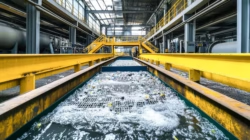Industrial PFAS Wastewater
Industrial PFAS Wastewater: A Comprehensive Guide to Challenges and Solutions
Introduction
As societal awareness of environmental contaminants has heightened over the past decade, per- and polyfluoroalkyl substances (PFAS) have emerged as a focal point in discussions regarding industrial wastewater management. For industries that rely on these substances, often referred to as “forever chemicals,” the urgency to mitigate environmental impacts has never been greater. As of July 2025, the regulatory landscape surrounding PFAS is rapidly evolving, provoking critical questions: What are the regulatory requirements for industrial PFAS wastewater? What treatment options are available? And how can industries comply while maintaining operational efficiency?
This article will delve into the complexities of industrial PFAS wastewater, exploring its sources, regulatory frameworks, treatment methodologies, and implications for various stakeholders, including plant operators, municipal directors, and design engineers.
Understanding PFAS: Composition and Sources
What Are PFAS?
PFAS are a class of synthetic compounds characterized by carbon-fluorine bonds, which confer notable stability and resistance to heat, water, and oil. These attributes have led to their widespread use in various industrial applications, including firefighting foams, food packaging, stain-resistant textiles, and industrial coatings. As of 2025, approximately 4000 distinct PFAS compounds have been identified, with notable ones including:
- Perfluorooctanoic acid (PFOA)
- Perfluorooctane sulfonate (PFOS)
- GenX chemicals
Industrial Sources of PFAS
Industries such as textiles, aerospace, automotive, and chemical manufacturing heavily utilize PFAS, leading to substantial contributions to wastewater streams. The U.S. EPA reported in early 2025 that industrial facilities are among the primary sources of PFAS contamination in surface waters and groundwater, adversely impacting ecosystems and human health.
Regulatory Landscape Governing PFAS
Current Regulations and Guidelines
As of July 2025, the regulatory environment for PFAS is rapidly changing. The U.S. EPA has moved forward with stringent guidelines, enforcing the following:
- National Pollutant Discharge Elimination System (NPDES): Facilities discharging PFAS must meet specific limits, commonly set at parts per trillion (ppt), with ongoing research indicating that limits could further tighten as more data becomes available.
- Safe Drinking Water Act (SDWA): Draft standards for PFAS in drinking water are under consultation, with proposed Maximum Contaminant Levels (MCLs) for PFOA and PFOS set to be enforced.
In addition to federal guidelines, states have begun to adopt their own regulations, creating a complex patchwork of requirements that industries must navigate.
Global Perspectives
Internationally, regulatory bodies are also addressing PFAS issues. For instance, the European Union (EU) has implemented directives categorizing some PFAS as hazardous substances, necessitating significant reporting and remediation efforts.
Implications of Non-Compliance
Financial Consequences
Failure to comply with PFAS regulations can result in hefty fines, costly remediation mandates, and reputational damage. For instance, settlements in PFAS-related lawsuits have reached millions, emphasizing the need for proactive measures.
Environmental and Public Health Impact
The persistence of PFAS in the environment poses long-term risks, including bioaccumulation and potential health effects such as cancer and immune dysfunction. This has raised public awareness and activism, pressuring companies to adopt more sustainable practices.
Treatment Technologies for Industrial PFAS Wastewater
The treatment of industrial PFAS wastewater is challenging due to the stability of these compounds. However, several technologies have emerged as potential solutions:
1. Adsorption
Granular Activated Carbon (GAC): This method employs carbon media to adsorb PFAS from water. While GAC is effective for certain PFAS types, it’s essential to monitor breakthrough levels to ensure efficacy.
Ion Exchange: Ion exchange resins can selectively remove PFAS. Although highly efficient, this technology requires regular replacement of the resin, posing a logistical challenge for industries.
2. Advanced Oxidation Processes (AOPs)
AOPs involve generating hydroxyl radicals to oxidize PFAS. Technologies such as ultraviolet (UV) light coupled with hydrogen peroxide have shown promise but may be cost-prohibitive for widespread adoption.
3. Membrane Filtration
Reverse Osmosis (RO): This technology is highly effective at removing PFAS compounds. Although it can be energy-intensive, ongoing advancements are leading to more efficient membrane systems.
4. Thermal Destruction
High-temperature incineration can effectively destroy PFAS but raises concerns over emissions and fulvic acid production, necessitating careful management.
5. Bioremediation (Emerging Research)
Research is ongoing into the potential for specific microbial strains to degrade PFAS, which, if successful, could revolutionize the treatment landscape.
Best Practices for Managing Industrial PFAS Wastewater
Compliance Strategies
-
Regular Audits: Implementing routine inspections and audits can help facilities maintain compliance and reduce the risk of PFAS discharges.
-
Training and Education: Continuous training for staff on emerging PFAS regulations and treatment technologies is crucial.
-
Collaborative Partnerships: Engaging with local authorities and environmental consultants can provide insights into the latest regulatory changes and innovative approaches to treatment.
Performance Monitoring
Establishing a comprehensive monitoring program is vital for assessing the effectiveness of treatment systems. Utilization of advanced analytical methods, including mass spectrometry and high-performance liquid chromatography, can aid in obtaining accurate PFAS concentrations.
Community Engagement
Transparent communication with the local community about PFAS management practices fosters trust and can mitigate reputational risks.
Conclusion
The landscape of industrial PFAS wastewater management is fraught with complexity and rapid change. As regulations tighten and public scrutiny intensifies, industries must adopt innovative treatment solutions and proactive compliance strategies. Understanding the multifaceted nature of PFAS—from sources and regulatory requirements to treatment technologies and best practices—empowers stakeholders to navigate this challenging environment effectively.
By taking meaningful action now, industries can not only comply with current regulations but also position themselves as leaders in environmental responsibility—an invaluable asset in today’s market.
As we move further into 2025, continued research, collaboration, and technological advancement will be critical in overcoming the challenges posed by industrial PFAS wastewater, ensuring a healthier planet for future generations.


